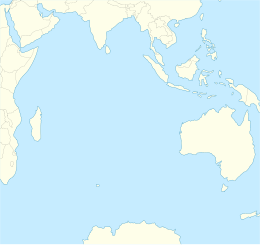Îles Crozet
|
Crozet Islands Îles Crozet
|
|
|---|---|

Flag
|
|
|
Motto: "Liberté, égalité, fraternité"
|
|
|
Anthem: La Marseillaise
|
|

Orthographic projection centred over the Îles Crozet.
|

One of the Crozet Islands
|
|
| Geography | |
|---|---|
| Location | Indian Ocean |
| Coordinates | 46°25′S 51°59′E / 46.417°S 51.983°ECoordinates: 46°25′S 51°59′E / 46.417°S 51.983°E |
| Archipelago | Crozet Islands |
| Total islands | 6 |
| Major islands | 3 |
| Area | 352 km2 (136 sq mi) |
| Highest elevation | 1,090 m (3,580 ft) |
| Highest point | Mont Marion-Dufresne |
| Administration | |
| Overseas territory | French Southern and Antarctic Lands |
| District | Crozet Islands |
| Demographics | |
| Population | 18 (winter) 30 (summer) |
The Crozet Islands (French: Îles Crozet; or, officially, Archipel Crozet) are a sub-antarctic archipelago of small islands in the southern Indian Ocean. They form one of the five administrative districts of the French Southern and Antarctic Lands.
The Crozet Islands were discovered on 24 January 1772 by the expedition of French explorer Marc-Joseph Marion du Fresne, aboard Le Mascarin. His second-in-command Jules (Julien-Marie) Crozet landed on Île de la Possession, claiming the archipelago for France. The expedition continued east and landed at New Zealand, where Captain Marion and much of his crew were killed and cannibalized by Maori. Crozet survived the disaster, and successfully led the survivors back to their base at Mauritius. In 1776 Crozet met James Cook at Cape Town, at the onset of Cook's third voyage. Crozet shared the charts of his ill-fated expedition, and as Cook sailed eastward he stopped at the islands, naming the western group Marion and the eastern group Crozet. In the following years, sealers visiting the islands referred to both the eastern and western groups as the Crozet Islands, and Marion Island became the name of the larger of the two Prince Edward Islands, which were discovered by Captain Marion on the same expedition.
In the early 19th century, the islands were often visited by sealers, to the extent that the seals had been nearly exterminated by 1835. Subsequently, whaling was the main activity around the islands, especially by the whalers from Massachusetts. In 1841 there were a dozen whaleships around the islands. Within a couple of years this had increased to twenty from the United States alone. Such exploitation was short-lived, and the islands were rarely visited for the rest of the century.
...
Wikipedia

